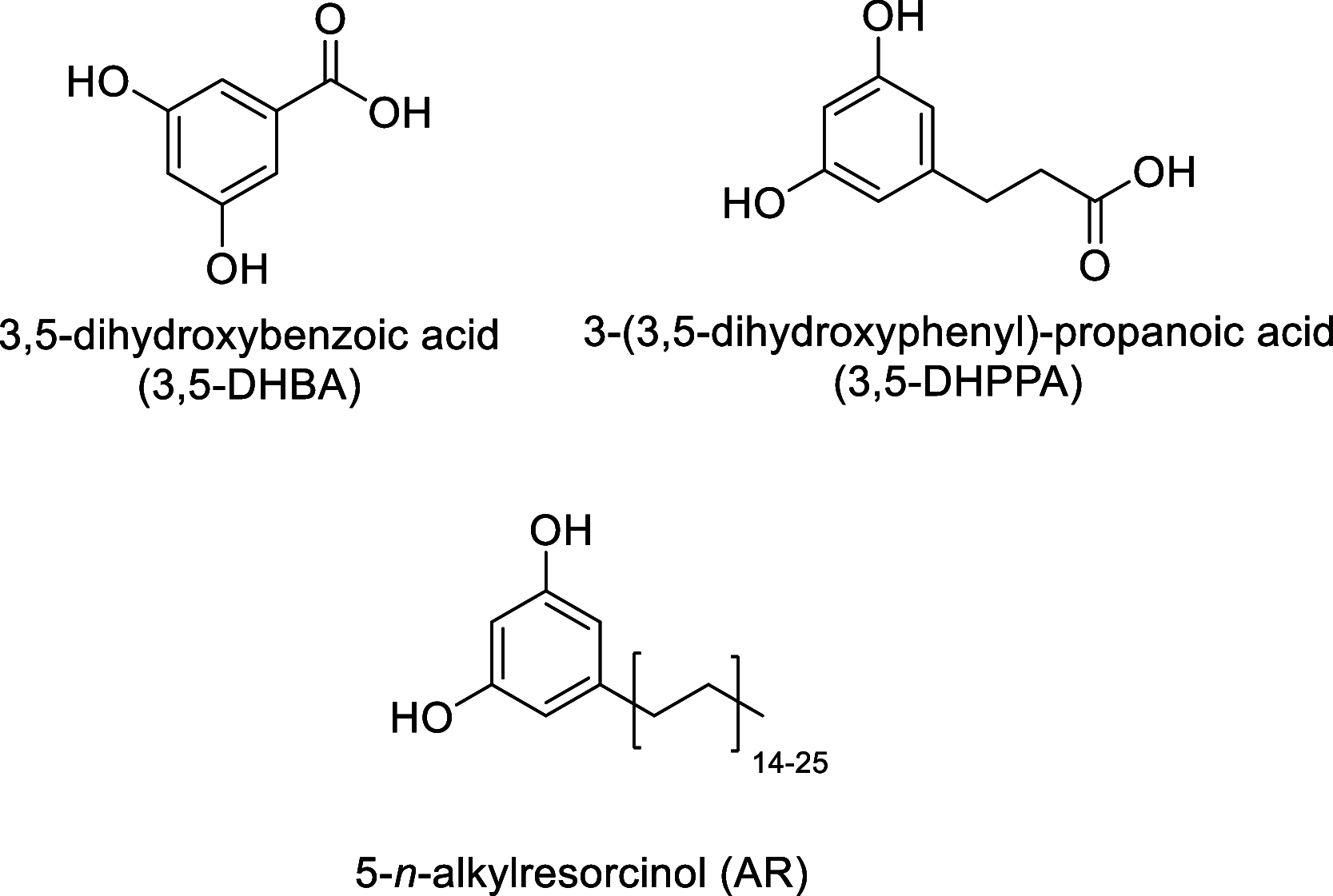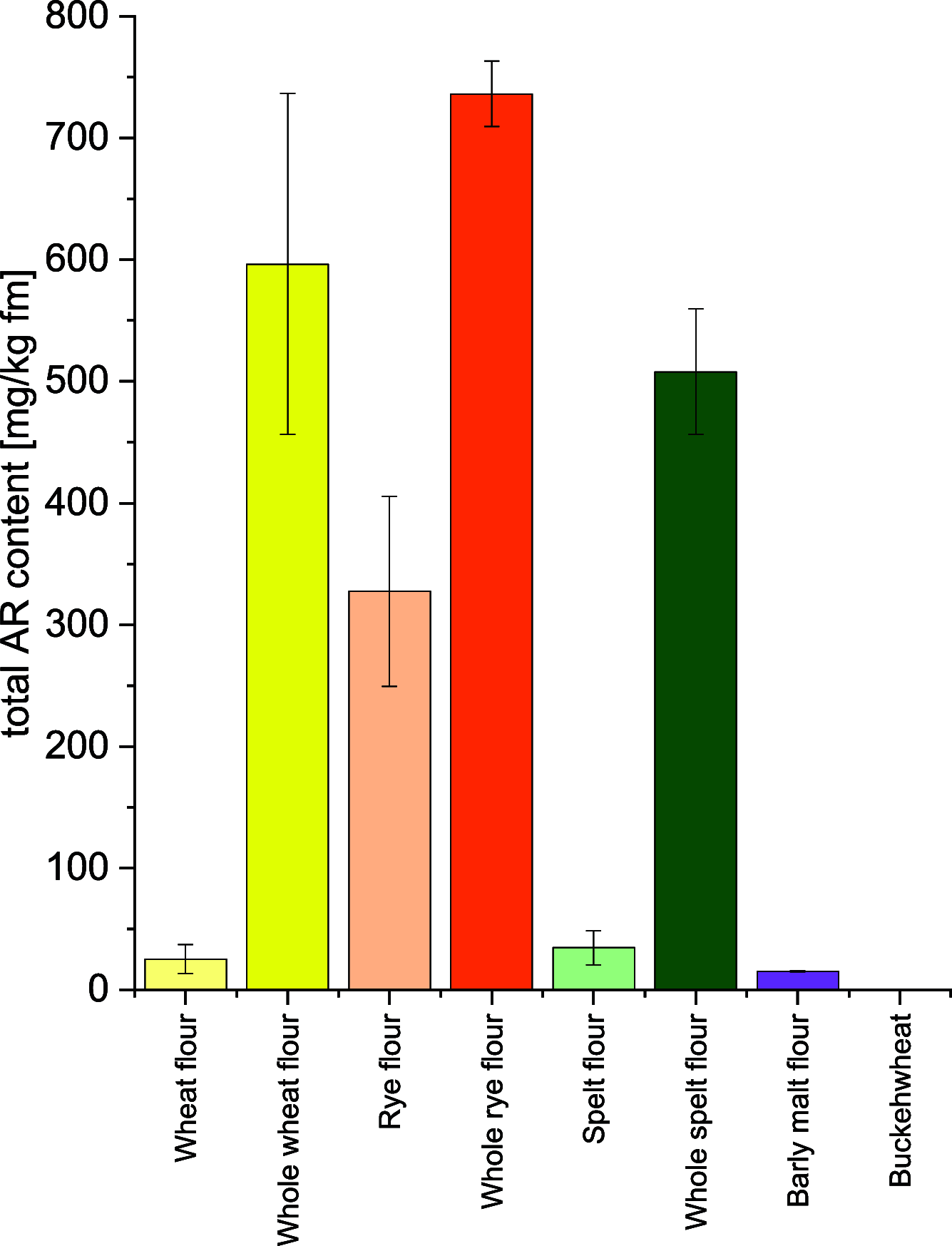Human Intervention Study: Alkylresorcinol Metabolites as Potential Biomarkers for Grain Intake and the Occurrence of Alkylresorcinols in Commonly Consumed Foods in the German Retail Sector
- PMID: 38854560
- PMCID: PMC11154960
- DOI: 10.1021/acsomega.4c00733
Human Intervention Study: Alkylresorcinol Metabolites as Potential Biomarkers for Grain Intake and the Occurrence of Alkylresorcinols in Commonly Consumed Foods in the German Retail Sector
Abstract
Grains are one of the primary nutrients and are associated with many health benefits. To reflect the intake of grain-based products, two promising potential biomarkers are alkylresorcinol (AR) metabolites 3,5-dihydroxybenzoic acid (3,5-DHBA) and 3-(3,5-dihydroxyphenyl)-propanoic acid (3,5-DHPPA). The aim of this study was to validate the occurrence of AR in food samples and investigate the suitability of their metabolites as potential biomarkers in human intervention studies. In the first step, the AR content in different grain products from the German retail sector was analyzed by GC-MS. ARs were found in higher concentrations in whole grain products and in moderate contents in refined grains and quinoa. Based on these results, human intervention studies were performed in the next step, and the AR metabolites 3,5-DHBA and 3,5-DHPPA were analyzed by LC-MS/MS in urine samples. The intake of only whole grain products leads to an increasing level of both potential biomarkers, while a refined grain diet shows decreasing levels of the AR metabolites. The excretion of 3,5-DHBA after a whole grain-rich diet differs significantly (p = 0.043) from no grain intake.
© 2024 The Authors. Published by American Chemical Society.
Conflict of interest statement
The authors declare no competing financial interest.
Figures






Similar articles
-
Identification and pharmacokinetics of novel alkylresorcinol metabolites in human urine, new candidate biomarkers for whole-grain wheat and rye intake.J Nutr. 2014 Feb;144(2):114-22. doi: 10.3945/jn.113.184663. Epub 2013 Nov 20. J Nutr. 2014. PMID: 24259554
-
Urinary 3-(3,5-dihydroxyphenyl)-1-propanoic acid, an alkylresorcinol metabolite, is a potential biomarker of whole-grain intake in a U.S. population.J Nutr. 2008 Oct;138(10):1957-62. doi: 10.1093/jn/138.10.1957. J Nutr. 2008. PMID: 18806107
-
Simultaneous pharmacokinetic modeling of alkylresorcinols and their main metabolites indicates dual absorption mechanisms and enterohepatic elimination in humans.J Nutr. 2014 Nov;144(11):1674-80. doi: 10.3945/jn.114.196220. Epub 2014 Sep 10. J Nutr. 2014. PMID: 25332465
-
Biomarkers of cereal food intake.Genes Nutr. 2019 Oct 12;14:28. doi: 10.1186/s12263-019-0651-9. eCollection 2019. Genes Nutr. 2019. PMID: 31632507 Free PMC article. Review.
-
[5-n-alkylresorcinols of whole grain cereals and whole grain cereal products as biomarkers of healthy food].Postepy Biochem. 2007;53(3):287-96. Postepy Biochem. 2007. PMID: 18399357 Review. Polish.
Cited by
-
Investigation of Potential Food Intake Biomarkers by LC-MS/MS: Suitability Under Conditions Close to Everyday Live.Mol Nutr Food Res. 2025 Jan;69(1):e202400575. doi: 10.1002/mnfr.202400575. Epub 2024 Dec 20. Mol Nutr Food Res. 2025. PMID: 39707646 Free PMC article.
References
LinkOut - more resources
Full Text Sources
Research Materials
Miscellaneous
